Introduction
Methods
1. Chemicals
2. Animals
3. Irradiation
4. NO production
5. Enzyme-linked immunosorbent assays
6. Immunoblot analysis
7. Nuclear protein extraction and electrophoretic mobility shift assays
8. Statistical analysis
Results
1. NAMPT expression
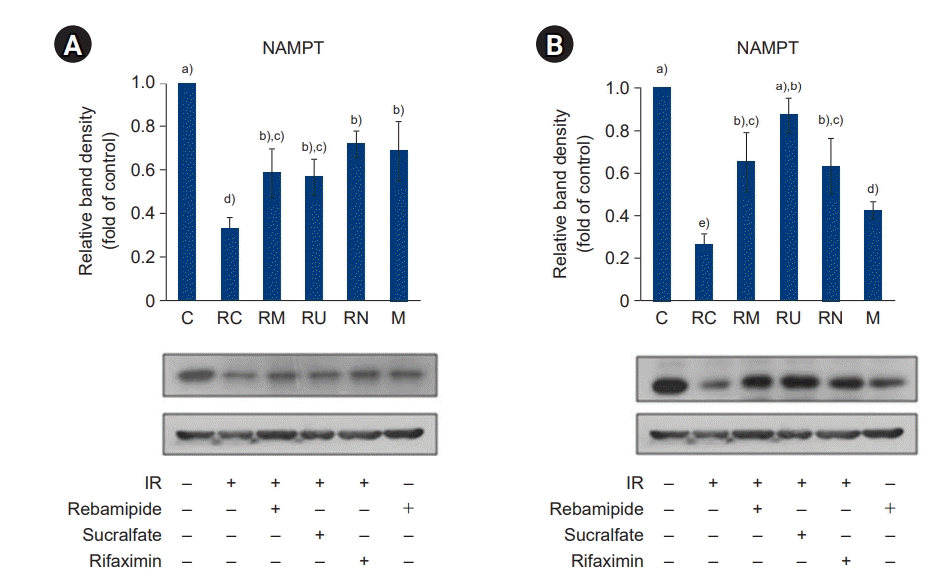 | Fig. 2.Effects of rebamipide, sucralfate, and rifaximin on the ionizing radiation (IR)-induced expression of nicotinamide phosphoribosyltransferase (NAMPT) in the large intestine (A) and small intestine (B). The expression of NAMPT was measured by immunoblotting. Bands were quantified using densitometry, and band intensities were compared with controls. Values are presented as mean±standard deviation (n=6). A vehicle-treated control group before sham irradiation (C); a vehicle-treated control group before irradiation (RC); a rebamipide-treated group before irradiation (RM); a sucralfate-treated group before irradiation (RU); a rifaximin-treated group before irradiation (RN); a rebamipide-treated control group before sham irradiation (M). a)-e) Bars with different letters are significantly different at p<0.05 according to the Tukey test. |
2. NAMPT increases Sirt1 expression and decreases PARP-1 expression
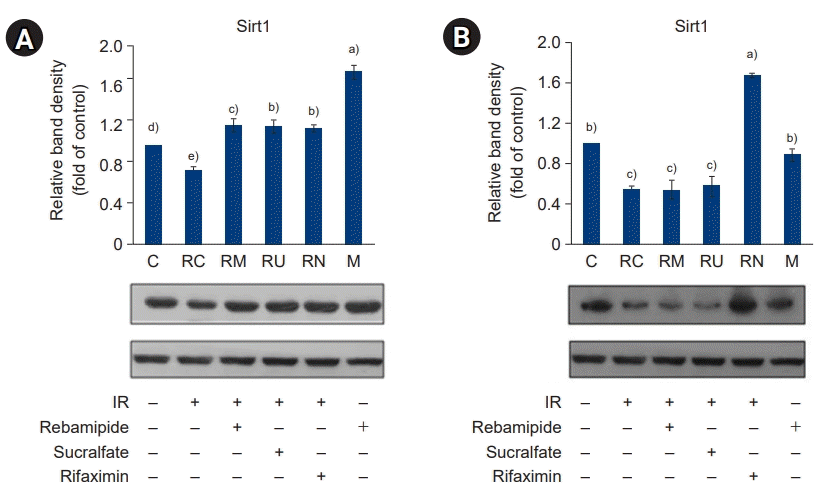 | Fig. 3.Effects of rebamipide, sucralfate, and rifaximin on the ionizing radiation (IR)-induced expression of silent information regulator factor 2-related enzyme (Sirt)1 in the large intestine (A) and small intestine (B). The expression of Sirt1 was measured by immunoblotting. Bands were quantified using densitometry, and band intensities were compared with controls. Values are presented as mean± standard deviation (n=6). A vehicle-treated control group before sham irradiation (C); a vehicle-treated control group before irradiation (RC); a rebamipide-treated group before irradiation (RM); a sucralfate-treated group before irradiation (RU); a rifaximin-treated group before irradiation (RN); a rebamipide-treated control group before sham irradiation (M). a)-e)Bars with different letters are significantly different at p<0.05 according to the Tukey test. |
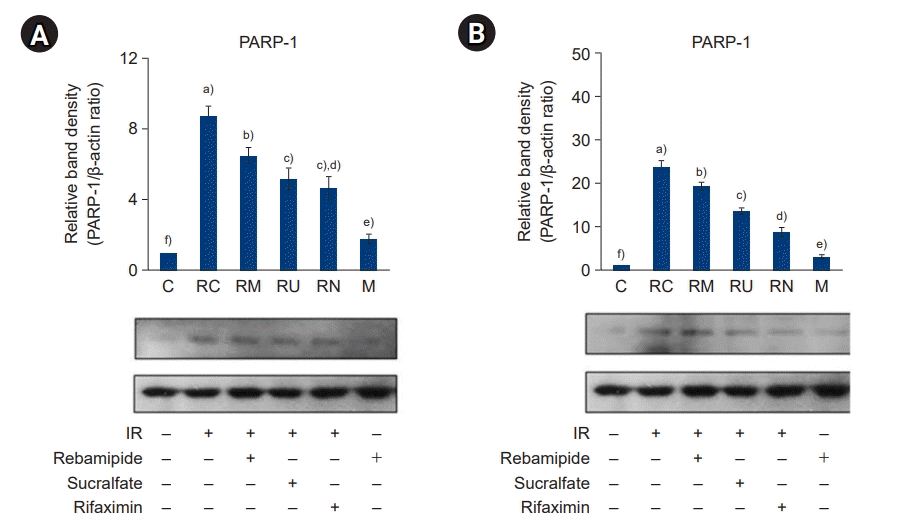 | Fig. 4.Effects of rebamipide, sucralfate, and rifaximin on the ionizing radiation (IR)-induced expression of poly-ADP-ribose polymerase (PARP)-1 in the large intestine (A) and small intestine (B). The expression of PARP-1 was measured by immunoblotting. Bands were quantified using densitometry, and band intensities were compared with controls. Values are presented as mean±standard deviation (n=6). A vehicle-treated control group before sham irradiation (C); a vehicle-treated control group before irradiation (RC); a rebamipide-treated group before irradiation (RM); a sucralfate-treated group before irradiation (RU); a rifaximin-treated group before irradiation (RN); a rebamipide-treated control group before sham irradiation (M). a)-f)Bars with different letters are significantly different at p<0.05 according to the Tukey test. |
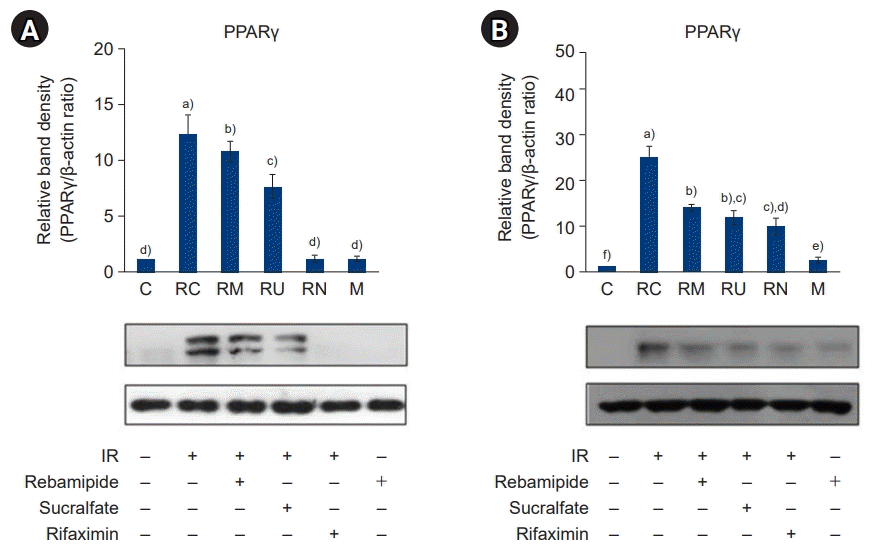 | Fig. 5.Effects of rebamipide, sucralfate, and rifaximin on the ionizing radiation (IR)-induced expression of peroxisome proliferator-activated receptor (PPAR)γ in the large intestine (A) and small intestine (B). The expression of PPARγ was measured by immunoblotting. Bands were quantified using densitometry, and band intensities were compared with controls. Values are presented as mean±standard deviation (n=6). A vehicle-treated control group before sham irradiation (C); a vehicle-treated control group before irradiation (RC); a rebamipide-treated group before irradiation (RM); a sucralfate-treated group before irradiation (RU); a rifaximin-treated group before irradiation (RN); a rebamipide-treated control group before sham irradiation (M). a)-f)Bars with different letters are significantly different at p<0.05 according to the Tukey test. |
3. Upregulation of Sirt1 and downregulation of PARP-1 by NAMPT
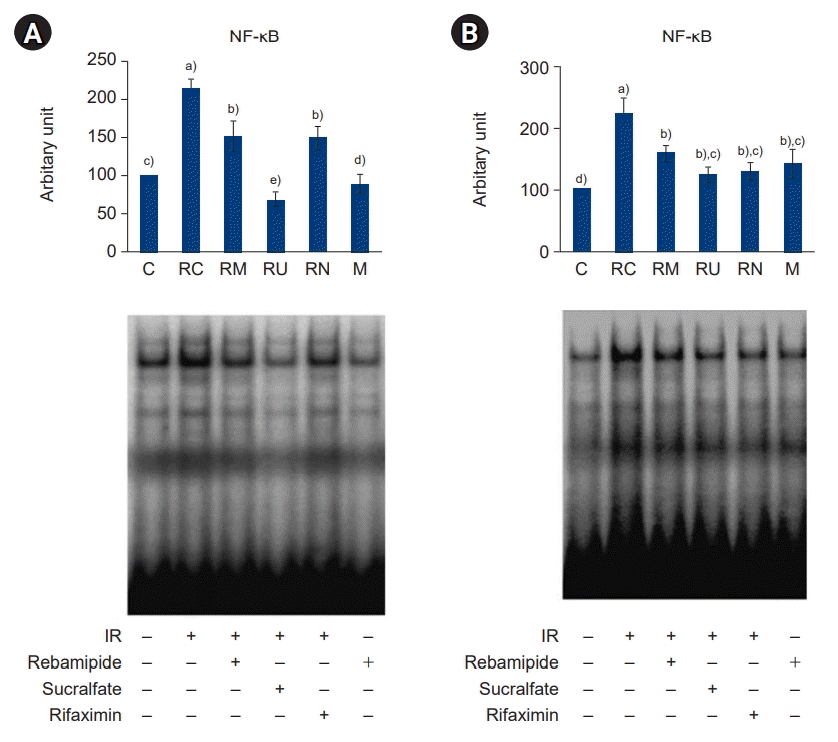 | Fig. 6.Effects of rebamipide, sucralfate, and rifaximin on the ionizing radiation (IR)-induced DNA binding activity of NF-κB in the large intestine (A) and small intestine (B) as determined by electrophoretic mobility shift assay analysis. The intensities of the bands were determined by densitometry analysis and are expressed as relative radioactive intensities. Values are presented as mean±standard deviation (n=6). A vehicle-treated control group before sham irradiation (C); a vehicle-treated control group before irradiation (RC); a rebamipide-treated group before irradiation (RM); a sucralfate-treated group before irradiation (RU); a rifaximin-treated group before irradiation (RN); a rebamipide-treated control group before sham irradiation (M). a)-c)Bars with different letters are significantly different at p<0.05 according to the Tukey test. |
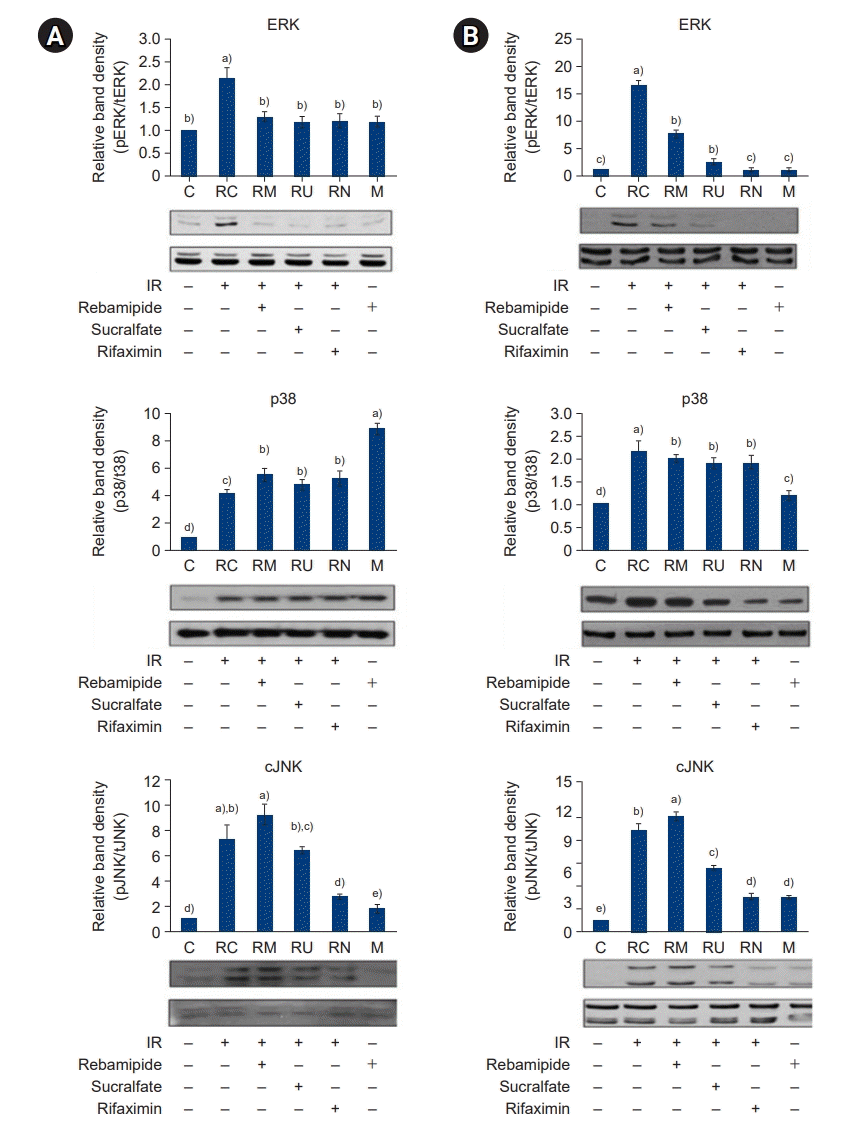 | Fig. 7.Effects of rebamipide, sucralfate, and rifaximin on the ionizing radiation (IR)-induced mitogen-activated protein kinase (MARK) activation in the large intestine (A) and small intestine (B). The activation of MAPKs was measured by immunoblotting. Bands were quantified using densitometry, and band intensities were compared with controls. Values are presented as mean±standard deviation (n=6). A vehicle-treated control group before sham irradiation (C); a vehicle-treated control group before irradiation (RC); a rebamipide-treated group before irradiation (RM); a sucralfate-treated group before irradiation (RU); a rifaximin-treated group before irradiation (RN); a rebamipide-treated control group before sham irradiation (M). a)-e)Bars with different letters are significantly different at p<0.05 according to the Tukey test. |
4. Downregulation of NF-κB and MAPK signaling by NAMPT
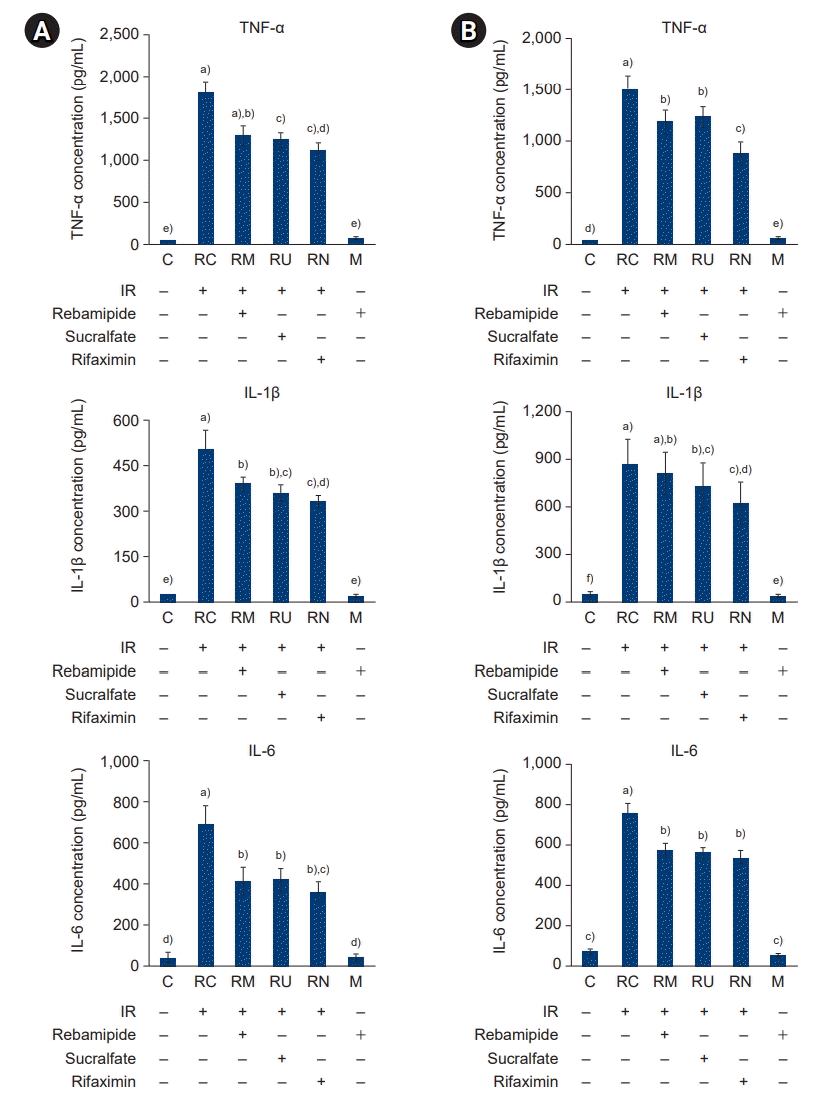 | Fig. 8.Effects of rebamipide, sucralfate, and rifaximin on the ionizing radiation (IR)-induced production of TNF-α, IL-1β, and IL-6 in the large intestine (A) and small intestine (B). The production of TNF-α, IL-1β, and IL-6 was measured using enzyme-linked immunosorbent assay kits according to the manufacturer’s instructions. Values are presented as mean±standard deviation (n=6). A vehicle-treated control group before sham irradiation (C); a vehicle-treated control group before irradiation (RC); a rebamipide-treated group before irradiation (RM); a sucralfate-treated group before irradiation (RU); a rifaximin-treated group before irradiation (RN); a rebamipide-treated control group before sham irradiation (M). a)-f)Bars with different letters are significantly different at p<0.05 according to the Tukey test. |
 | Fig. 9.Effects of rebamipide, sucralfate, and rifaximin on the ionizing radiation (IR)-induced production of major capsid protein (MCP)-1 in the large intestine (A) and small intestine (B). The production of MCP-1 was measured using an enzyme-linked immunosorbent assay kit according to the manufacturer’s instructions. Values are presented as mean±standard deviation (n=6). A vehicle-treated control group before sham irradiation (C); a vehicle-treated control group before irradiation (RC); a rebamipide-treated group before irradiation (RM); a sucralfate-treated group before irradiation (RU); a rifaximin-treated group before irradiation (RN); a rebamipide-treated control group before sham irradiation (M). a)-e)Bars with different letters are significantly different at p<0.05 according to the Tukey test. |
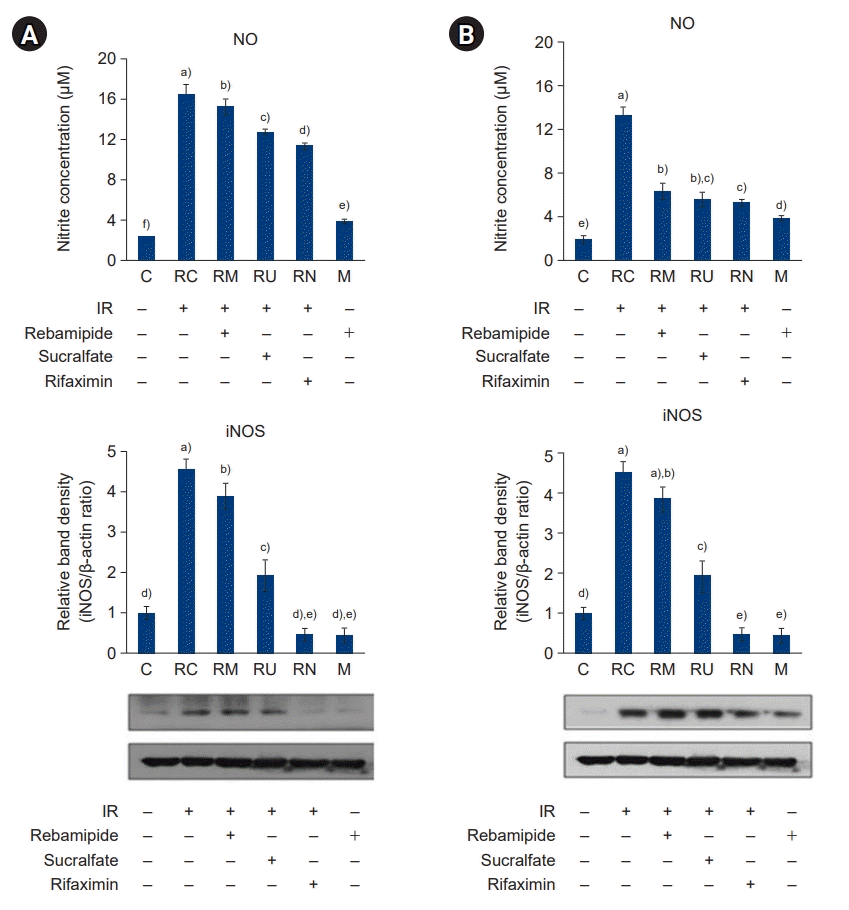 | Fig. 10.Effects of rebamipide, sucralfate, and rifaximin on the ionizing radiation (IR)-induced production of nitric oxide (NO) and expression of inducible NO synthase (iNOS) in the large intestine (A) and small intestine (B). The production of NO and expression of iNOS were measured using the Griess reagent system and an immunoblotting assay, respectively. Bands were quantified using densitometry, and band intensities were compared with controls. Values are presented as mean±standard deviation (n=6). A vehicle-treated control group before sham irradiation (C); a vehicle-treated control group before irradiation (RC); a rebamipide-treated group before irradiation (RM); a sucralfate-treated group before irradiation (RU); a rifaximin-treated group before irradiation (RN); a rebamipide-treated control group before sham irradiation (M). a)-f)Bars with different letters are significantly different at p<0.05 according to the Tukey test. |
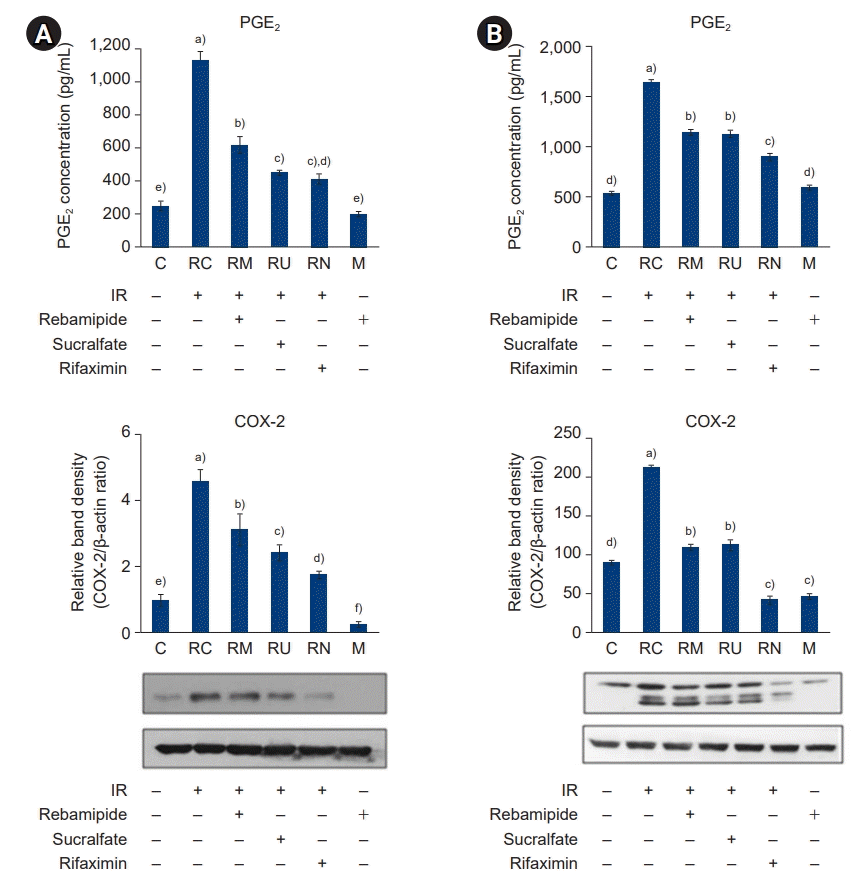 | Fig. 11.Effects of rebamipide, sucralfate, and rifaximin on the ionizing radiation (IR)-induced production of PGE2 and expression of COX-2 in the large intestine (A) and small intestine (B). The production of PGE2 and expression of COX-2 were measured using an enzyme-linked immunosorbent assay kit according to the manufacturer’s instructions and an immunoblotting assay, respectively. Bands were quantified using densitometry, and band intensities were compared with controls. Values are presented as mean±standard deviation (n=6). A vehicle-treated control group before sham irradiation (C); a vehicle-treated control group before irradiation (RC); a rebamipide-treated group before irradiation (RM); a sucralfate-treated group before irradiation (RU); a rifaximin-treated group before irradiation (RN); a rebamipide-treated control group before sham irradiation (M). a)-f)Bars with different letters are significantly different at p<0.05 according to the Tukey test. |
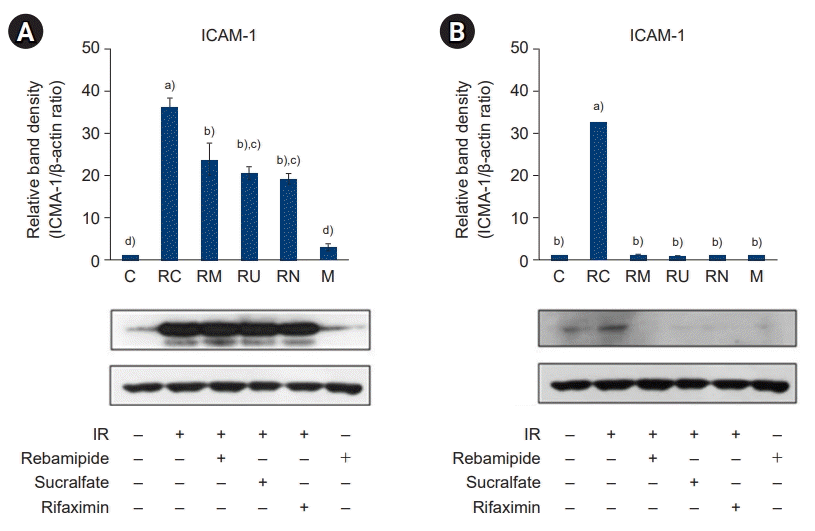 | Fig. 12.Effects of rebamipide, sucralfate, and rifaximin on the ionizing radiation (IR)-induced expression of intercellular adhesion molecule 1 (ICAM-1) in the large intestine (A) and small intestine (B). The expression of ICAM-1 was measured by immunoblotting. Bands were quantified using densitometry, and band intensities were compared with controls. Values are presented as mean±standard deviation (n=6). A vehicle-treated control group before sham irradiation (C); a vehicle-treated control group before irradiation (RC); a rebamipide-treated group before irradiation (RM); a sucralfate-treated group before irradiation (RU); a rifaximin-treated group before irradiation (RN); a rebamipide-treated control group before sham irradiation (M). a)-d)Bars with different letters are significantly different at p<0.05 according to the Tukey test. |
5. [Ca2+] oscillations
 | Fig. 13.Effects of rebamipide, sucralfate, and rifaximin on the ionizing radiation (IR)-induced [Ca2+] oscillations in the large intestine (A) and small intestine (B). IR induced an increase in [Ca2+] in the colons and small intestines of mice. Tissue cells were freshly isolated and stained with fluo-3 acetoxymethyl ester, attached to glass slides, and placed under a confocal microscope. The changes in fluorescence were monitored every 1.1 seconds for 100 seconds. The results are representative of 10 randomly chosen cells. Values are presented as mean±standard deviation (n=6). A vehicle-treated control group before sham irradiation (C); a vehicle-treated control group before irradiation (RC); a rebamipide-treated group before irradiation (RM); a sucralfate-treated group before irradiation (RU); a rifaximin-treated group before irradiation (RN); a rebamipide-treated control group before sham irradiation (M). a)-c)Bars with different letters are significantly different at p<0.05 according to the Tukey test. |
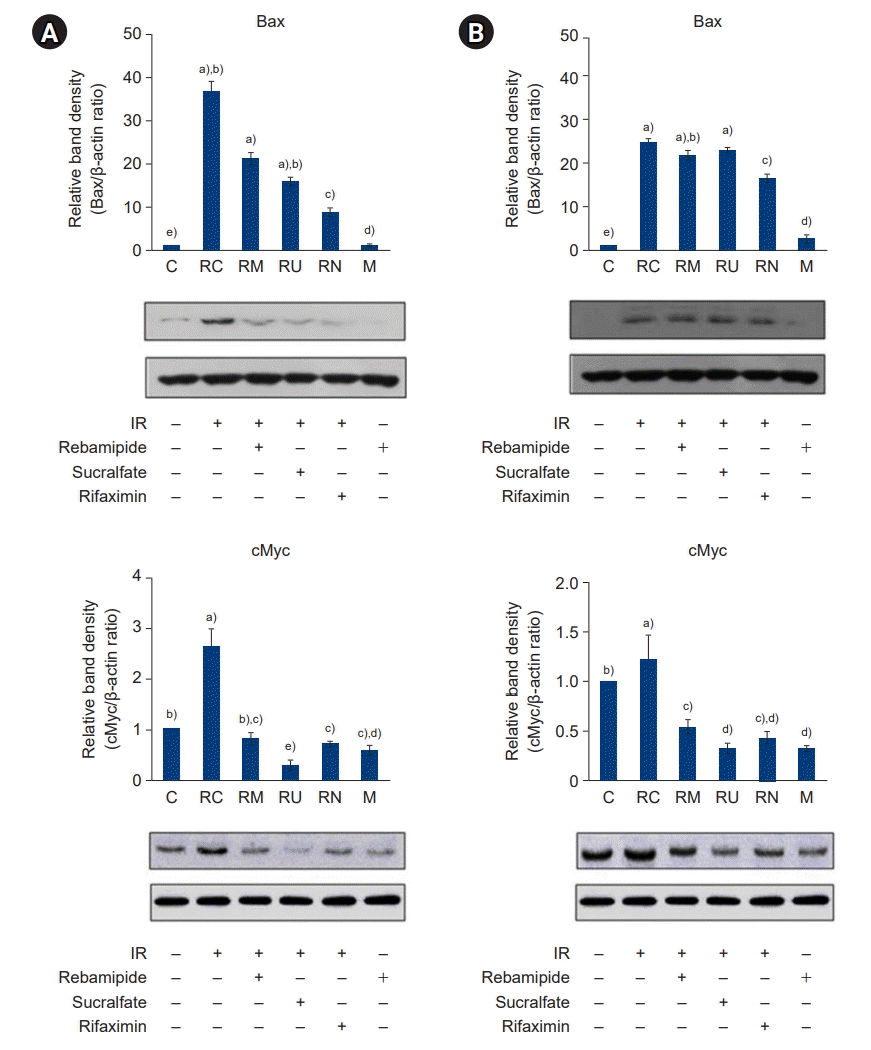 | Fig. 14.Effects of rebamipide, sucralfate, and rifaximin on the ionizing radiation (IR)-induced expression of Bax and c-Myc in the large intestine (A) and small intestine (B). The expression of Bax and c-Myc was measured by immunoblotting. Bands were quantified using densitometry, and band intensities were compared with controls. Values are presented as mean±standard deviation (n=6). A vehicle-treated control group before sham irradiation (C); a vehicle-treated control group before irradiation (RC); a rebamipide-treated group before irradiation (RM); a sucralfate-treated group before irradiation (RU); a rifaximin-treated group before irradiation (RN); a rebamipide-treated control group before sham irradiation (M). a)-e)Bars with different letters are significantly different at p<0.05 according to the Tukey test. |
 | Fig. 15.Effects of rebamipide, sucralfate, and rifaximin on the ionizing radiation (IR)-induced expression of Bcl-2 and Bcl-xL in the large intestine (A) and small intestine (B). The expression of Bcl-2 and Bcl-xL was measured by immunoblotting. Bands were quantified using densitometry, and band intensities were compared with controls. Values are presented as mean±standard deviation (n=6). A vehicle-treated control group before sham irradiation (C); a vehicle-treated control group before irradiation (RC); a rebamipide-treated group before irradiation (RM); a sucralfate-treated group before irradiation (RU); a rifaximin-treated group before irradiation (RN); a rebamipide-treated control group before sham irradiation (M). a)-f)Bars with different letters are significantly different at p<0.05 according to the Tukey test. |
6. Inhibition of cytochrome C release and the caspase cascade
 | Fig. 16.Effects of rebamipide, sucralfate, and rifaximin on the ionizing radiation (IR)-induced expression of cytochrome C in the large intestine (A) and small intestine (B). The expression of cytochrome C was measured by immunoblotting. Bands were quantified using densitometry, and band intensities were compared with controls. Values are presented as mean±standard deviation (n=6). A vehicle-treated control group before sham irradiation (C); a vehicle-treated control group before irradiation (RC); a rebamipide-treated group before irradiation (RM); a sucralfate-treated group before irradiation (RU); a rifaximin-treated group before irradiation (RN); a rebamipide-treated control group before sham irradiation (M). a)-f)Bars with different letters are significantly different at p<0.05 according to the Tukey test. |
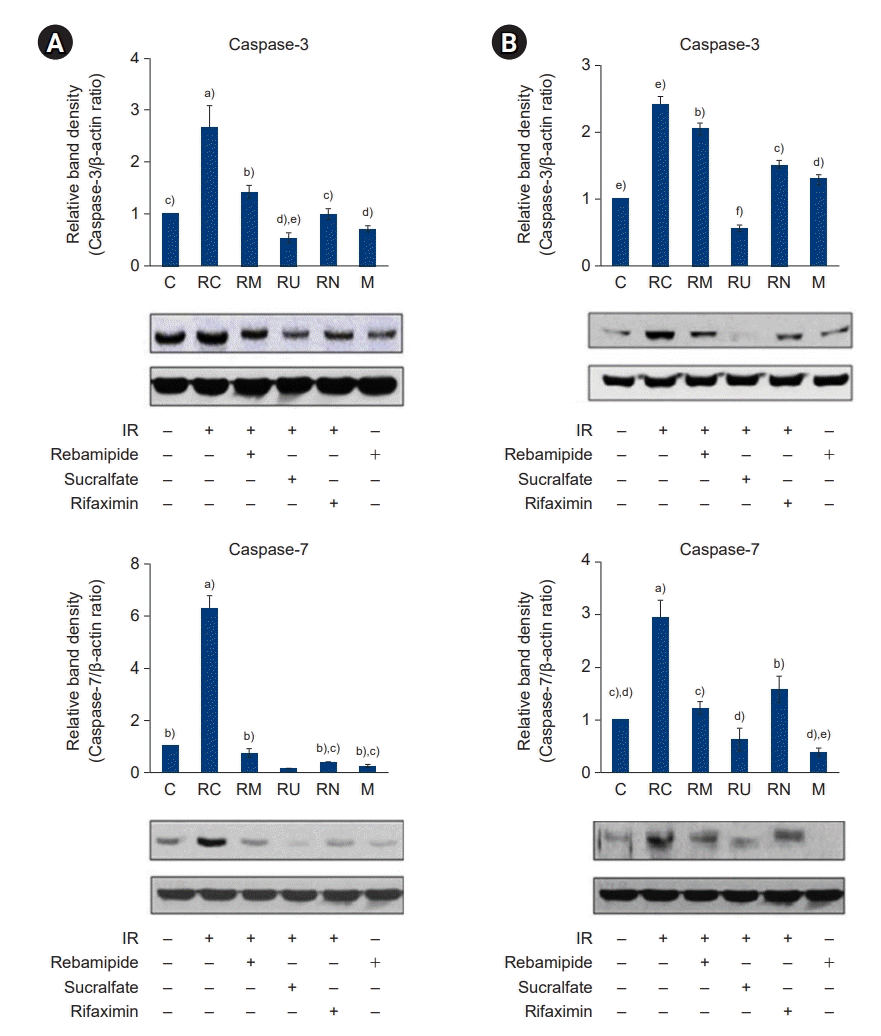 | Fig. 17.Effects of rebamipide, sucralfate, and rifaximin on the ionizing radiation (IR)-induced expression of caspase-3 and caspase-7 in the large intestine (A) and small intestine (B). The expression of caspase-3 and caspase-7 was measured by immunoblotting. Bands were quantified using densitometry, and the intensity of bands was compared with controls. Values are presented as mean±standard deviation (n=6). A vehicle-treated control group before sham irradiation (C); a vehicle-treated control group before irradiation (RC); a rebamipide-treated group before irradiation (RM); a sucralfate-treated group before irradiation (RU); a rifaximin-treated group before irradiation (RN); a rebamipide-treated control group before sham irradiation (M). a)-f)Bars with different letters are significantly different at p<0.05 according to the Tukey test. |




 PDF
PDF Citation
Citation Print
Print



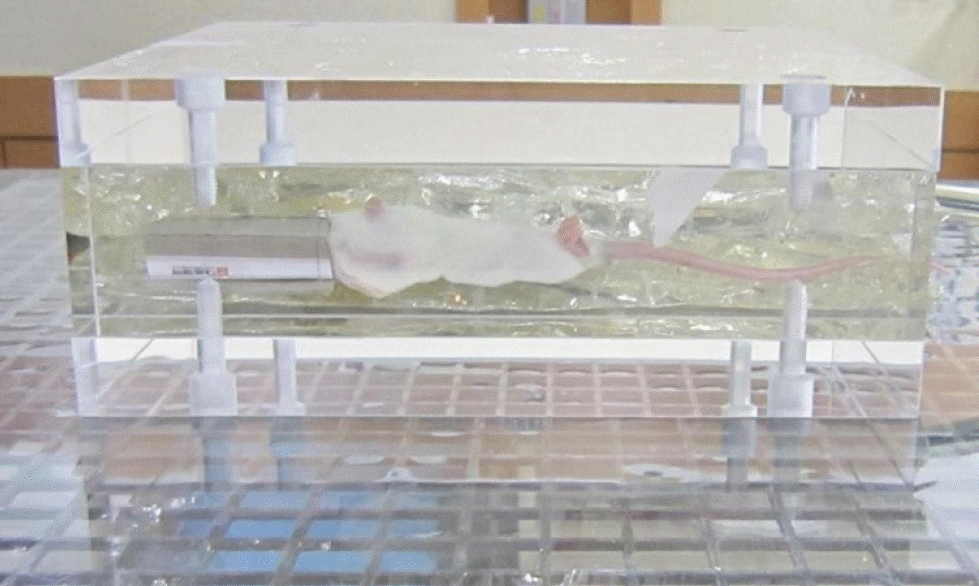
 XML Download
XML Download